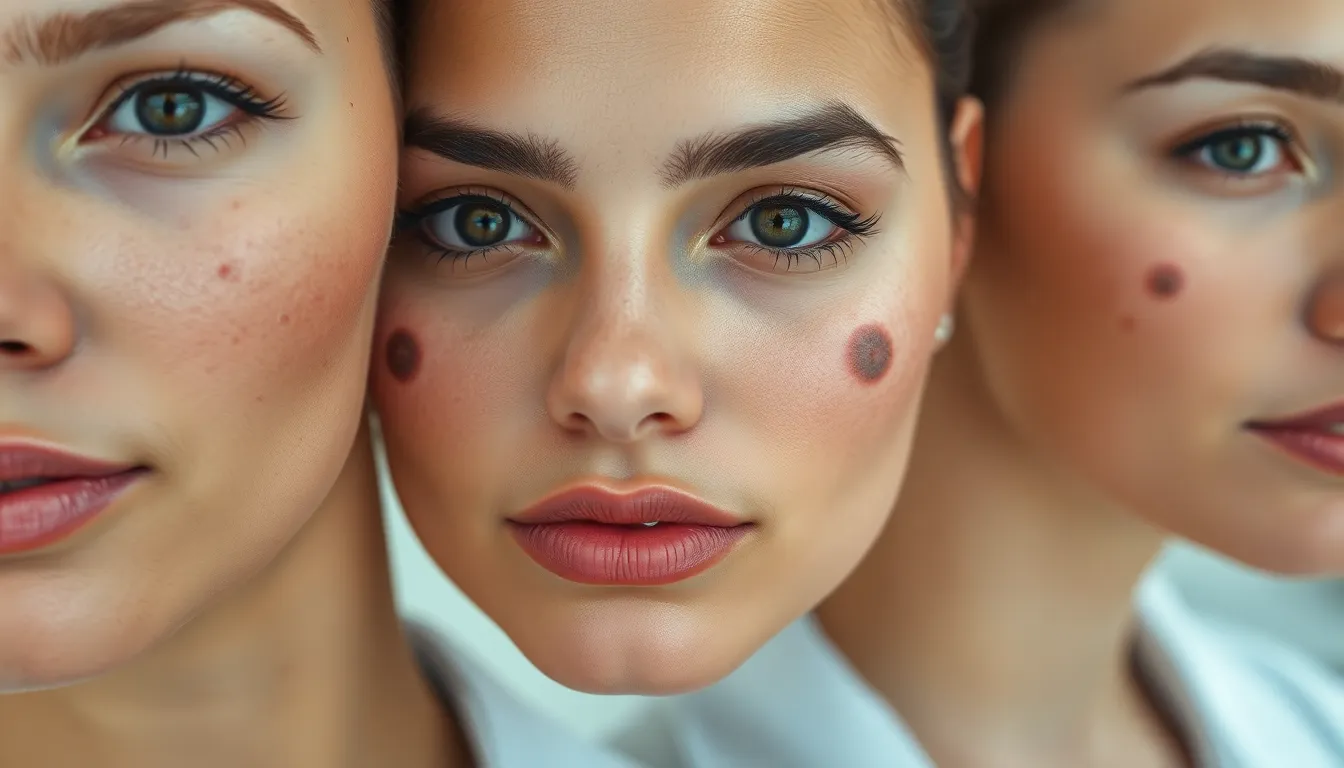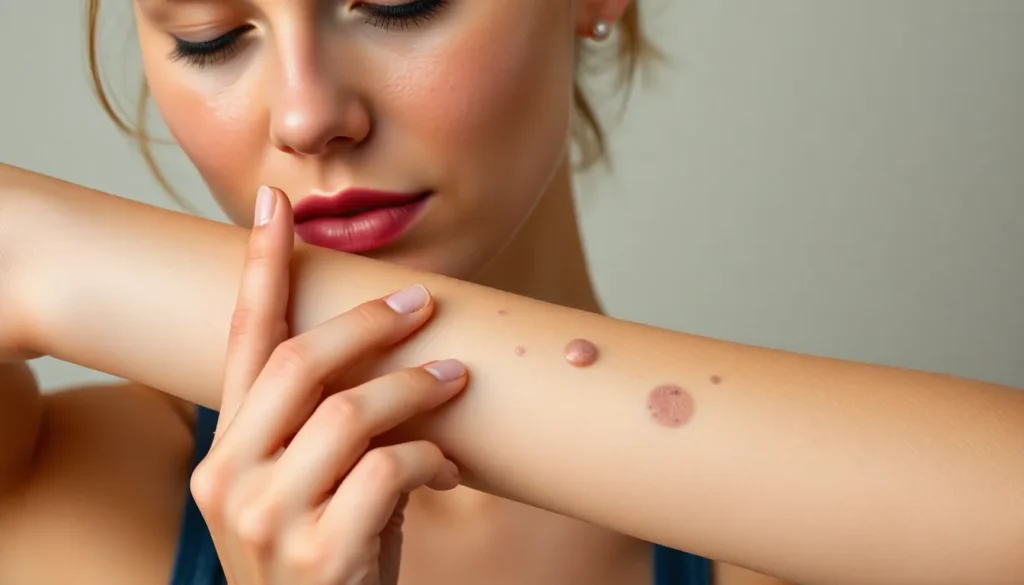Table of Contents
ToggleMoles are common skin growths that can appear anywhere on the body. They often come in various shapes, sizes, and colors, making them a frequent topic of curiosity. While most moles are harmless, understanding their nature is essential for maintaining skin health.
These tiny skin marks develop when skin cells called melanocytes grow in clusters instead of being spread throughout the skin. Factors like genetics and sun exposure play a significant role in their formation. By learning more about moles, individuals can better recognize changes that may signal the need for a dermatologist’s evaluation.
What Are Moles on Skin
Moles are small growths on the skin that typically appear as brown or black spots. These growths are made up of melanocytes, which are cells that produce pigment. Moles can range in size from a few millimeters to several centimeters and can be flat or raised.
Moles develop due to a combination of genetic factors and environmental influences, such as sun exposure. Most individuals have between 10 and 40 moles by adulthood, with some people developing additional moles over time. Moles can change with age, becoming darker, lighter, or even hairier.
While most moles are benign and pose no health risks, it’s crucial to monitor them for any changes. Characteristics of concerning moles include asymmetry, irregular borders, varied colors, large diameter (over 6 millimeters), or any changes in size, shape, or color. Regular skin checks help in identifying any abnormalities that may indicate skin cancer or other conditions, warranting consultation with a dermatologist.
Types of Moles

Moles on the skin fall into distinct categories, each with unique characteristics. Understanding these types aids in monitoring skin health effectively.
Common Moles
Common moles, or nevi, usually appear as small, round, brown, or black spots. They measure between 1 and 5 millimeters in diameter. These moles typically possess smooth, even borders and uniform color. Common moles develop from melanocytes and remain stable throughout life. Most individuals possess approximately 10 to 40 common moles by adulthood. Regular monitoring helps ensure they maintain their characteristics without any concerning changes.
Atypical Moles
Atypical moles, or dysplastic nevi, display irregular shapes and varied colors. They may be larger than 5 millimeters and feature uneven borders. These moles often have multiple shades, ranging from pink to brown. Atypical moles signify a higher risk for developing melanoma, thus warranting close observation. Individuals with a family history of atypical moles or skin cancer should consult with a dermatologist for regular evaluations.
Causes of Moles on Skin
Moles develop from a combination of genetic and environmental factors. Understanding these causes helps in monitoring skin health effectively.
Genetic Factors
Genetic factors significantly influence mole development. Individuals inherit genes that determine the number and appearance of moles. Family history plays a crucial role; if a parent or sibling has atypical moles or a history of skin cancer, the likelihood of developing similar moles increases. Additionally, people with fair skin often have more moles due to genetic predispositions that affect melanin production.
Environmental Factors
Environmental factors also contribute to moles on the skin. Sun exposure stands out as a primary risk factor; UV radiation stimulates melanocyte activity, leading to increased pigment production and mole formation. Frequent sunburns can heighten this risk, particularly in childhood. Other factors include hormonal changes, such as those occurring during puberty or pregnancy, which can alter mole appearance and growth patterns over time.
When to See a Doctor
Individuals should consult a doctor for any concerning changes in moles. Specific signs to watch for include:
- Asymmetry: If one half of the mole doesn’t match the other half.
- Irregular borders: Edges that are jagged, notched, or blurred.
- Varied colors: Different shades of brown, black, or other colors within the same mole.
- Large diameter: Moles larger than 6 millimeters, similar to a pencil eraser.
- Changes over time: Any shifts in size, shape, color, or elevation of the mole.
Patients with more than 50 moles, atypical moles, or a family history of skin cancer should undergo regular dermatological evaluations. Quick identification of abnormal characteristics in moles can lead to early diagnosis of potential skin issues, including melanoma.
Individuals noticing itching, bleeding, or crusting should seek immediate medical advice. These symptoms often indicate irritation or more serious conditions requiring professional assessment.
Heed any other unusual changes in the skin, as these can signify broader health concerns. Regular self-examinations and consultations with dermatologists support proactive skin health management.
Treatment Options for Moles
Various treatment options exist for moles, ranging from home remedies to medical procedures depending on individual preferences and medical guidance.
Home Remedies
Home remedies for moles include natural treatments some individuals choose to try, though their effectiveness lacks scientific backing. Common methods include:
- Apple Cider Vinegar: Some apply apple cider vinegar directly to the mole, believing its acidity helps dissolve the mole over time.
- Garlic: Applying crushed garlic to the mole may promote skin peeling due to its enzyme content.
- Tea Tree Oil: This essential oil is often used for its purported skin benefits, with users applying it directly to the mole daily.
- Aloe Vera: Aloe vera gel might soothe the skin, promoting healing when applied regularly.
It’s crucial to note that while these remedies are popular, consulting a dermatologist before trying them ensures safety, particularly with moles that show concerning characteristics.
Medical Procedures
Medical procedures provide effective removal options for moles deemed problematic or unwanted. Commonly utilized treatments include:
- Excision: A surgeon removes the mole along with some surrounding skin, ensuring complete extraction for thorough analysis, particularly if malignant concerns exist.
- Shave Removal: Involves shaving off the mole at the skin’s surface level. This method minimizes scarring but may not be suitable for all moles.
- Laser Therapy: Laser technology can target specific moles, breaking down pigment without affecting surrounding areas. This non-invasive option suits certain mole types but isn’t recommended for deeper lesions.
- Cryotherapy: Freezing the mole with liquid nitrogen can effectively remove various moles over a series of sessions. This method often requires follow-up to ensure full removal.
Consultation with a dermatologist will determine the most appropriate medical procedure based on the individual’s skin health and specific mole characteristics.
Moles are a common aspect of skin health that require attention and understanding. While most moles are benign, recognizing changes in their appearance can be crucial for early detection of potential issues. Regular self-examinations and professional evaluations play a significant role in maintaining skin health. Individuals should stay informed about the characteristics of their moles and consult a dermatologist when necessary. With a proactive approach to monitoring skin changes, individuals can ensure their skin remains healthy and address any concerns promptly.





